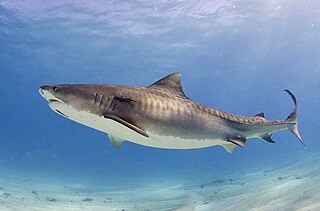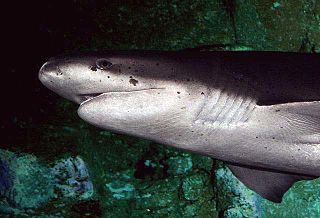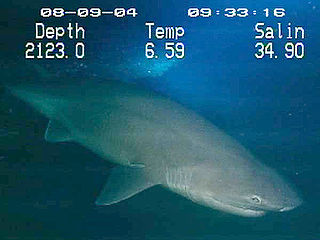
Carcharhiniformes, the ground sharks, are the largest order of sharks, with over 270 species. They include a number of common types, such as catsharks, swellsharks, and requiem sharks.

Scyliorhinus is a genus of catsharks in the family Scyliorhinidae. This genus is known in the fossil records from the Cretaceous period, late Albian age to the Pliocene epoch.

Galeocerdo is a genus of ground shark. Only a single species, G. cuvier, the tiger shark is extant. The earliest fossils date back to the early Eocene epoch, (Ypresian), around 56–47.8 Million years ago. While historically considered a member of the requiem shark family Carcharhinidae, it is currently considered to be the only member of the family Galeocerdonidae. While this genus was historically considered diverse, including 21 extinct species, morphometric analysis conducted in 2021 suggested that the diversity of the genus included only 5 extinct species much lower than previously assumed. The oldest fossils of the extant G. cuvier date to the middle Miocene.

The Hexanchiformes are a primitive order of sharks, numbering just seven extant species in two families. Fossil sharks that were apparently very similar to modern sevengill species are known from Jurassic specimens.

The Lamniformes are an order of sharks commonly known as mackerel sharks. It includes some of the most familiar species of sharks, such as the great white, as well as more unusual representatives, such as the goblin shark and megamouth shark.

Carpet sharks are sharks classified in the order Orectolobiformes. Sometimes the common name "carpet shark" is used interchangeably with "wobbegong", which is the common name of sharks in the family Orectolobidae. Carpet sharks have five gill slits, two spineless dorsal fins, and a small mouth that does not extend past the eyes. Many species have barbels.

Cow sharks are a shark family, the Hexanchidae, characterized by an additional pair or pairs of gill slits. Its 37 species are placed within the 10 genera: Gladioserratus, Heptranchias, Hexanchus, Notidanodon, Notorynchus, Pachyhexanchus, Paraheptranchias, Pseudonotidanus, Welcommia, and Weltonia.

Elasmobranchii is a subclass of Chondrichthyes or cartilaginous fish, including modern sharks, rays, skates, and sawfish. Members of this subclass are characterised by having five to seven pairs of gill clefts opening individually to the exterior, rigid dorsal fins and small placoid scales on the skin. The teeth are in several series; the upper jaw is not fused to the cranium, and the lower jaw is articulated with the upper. The details of this jaw anatomy vary between species, and help distinguish the different elasmobranch clades. The pelvic fins in males are modified to create claspers for the transfer of sperm. There is no swim bladder; instead, these fish maintain buoyancy with large livers rich in oil.
The Dalatiidae are the family of kitefin sharks of the order Squaliformes. Members of this family are small, under 2 m (6.6 ft) long, and are found worldwide. They have cigar-shaped bodies with narrow heads and rounded snouts. Several species have specialized bioluminescent organs. Though eight genera are in this family, four of them are monotypic.

Rajiformes is one of the four orders in the superorder Batoidea, flattened cartilaginous fishes related to sharks. Rajiforms are distinguished by the presence of greatly enlarged pectoral fins, which reach as far forward as the sides of the head, with a generally flattened body. The undulatory pectoral fin motion diagnostic to this taxon is known as rajiform locomotion. The eyes and spiracles are located on the upper surface of the head and the gill slits are on the underside of the body. Most species give birth to live young, although some lay eggs enclosed in a horny capsule.

The Forest Marble is a geological formation in England. Part of the Great Oolite Group, it dates to the late Bathonian stage of the Middle Jurassic.
Hemipristis curvatus is an extinct species of weasel shark which existed during the Eocene epoch. It was described by Dames in 1883.

Meristodonoides is an extinct genus of hybodont. The type species is M. rajkovichi, which was originally a species in the genus Hybodus. The species, along with other Hybodus species such as H. butleri and H. montanensis, was reassigned to Meristodonoides by Charlie J. Underwood and Stephen L. Cumbaa in 2010. The species is primarily known from remains from the Cretaceous of North America, spanning from the Aptian/Albian to Maastrichtian, making it one of the last surviving hybodont genera, though records of the genus likely extend back as far as the Late Jurassic, based on an undescribed skeleton from the Tithonian of England, and fragmentary teeth from the Kimmeridgian of Poland, England and Switzerland. Other remains of the genus are known from the Coniacian of England, the Aptian-Albian of France, and the Campanian of European Russia. The morphology of the teeth suggests an adaptation to tearing prey. Fossils from the Western Interior Seaway suggest that it preferred nearshore marine environments, being absent from deeper-water areas, with it likely also being able to tolerate brackish and freshwater conditions.
Orectoloboides is an extinct genus of wobbegong sharks. It was described by Cappetta in 1977. A new species, O. angulatus, was described from the Cenomanian age of Canada by Charlie J. Underwood and Stephen L. Cumbaa in 2010.

Pseudocorax is an extinct genus of mackerel sharks that lived during the Late Cretaceous. It contains six valid species that have been found in Europe, the Middle East, North Africa, and North America. It was formerly assigned to the family Anacoracidae, but is now placed in its own family Pseudocoracidae along with Galeocorax. The former species "P." australis and "P." primulus have been reidentified as species of Echinorhinus and Squalicorax, respectively.

Sclerorhynchoidei is an extinct suborder of rajiform rays that had long rostra with large denticles similar to sawfishes and sawsharks. This feature was convergently evolved and their closest living relatives are actually skates. While they are often called "sawfishes", sawskates is a more accurate common name for sclerorhynchoids. The suborder contains five named families: Ganopristidae, Ischyrhizidae, Onchopristidae, Ptychotrygonidae, and Schizorhizidae. Several genera are not currently placed in any of these families. Sclerorhynchoids first appeared in the Barremian and went extinct during the Cretaceous–Paleogene extinction event, with former Paleocene occurrences being misidentifications or reworked specimens. One female specimen of Libanopristis with nine embryos preserved in situ represents one of the first fossil evidence of batoid ovoviviparity.

Rhinopristiformes is an order of rays, cartilaginous fishes related to sharks, containing shovelnose rays and allied groups.

Synechodontiformes is an extinct order of prehistoric shark-like cartilaginous fish, known from the Permian to the Paleogene. They are considered to be members of Neoselachii, the group that contains modern sharks and rays.

Paracestracion is an extinct genus of heterodontiform sharks from Early Jurassic to Early Cretaceous-aged rocks of England, France, Germany and Luxembourg. The genus was first described in 1911 by Ernst Hermann Friedrich von Koken in Karl Alfred von Zittel.
Eoptolamna is an extinct genus of mackerel sharks that lived during the Cretaceous. It contains two valid species, E. eccentrolopha and E. supracretacea, which have been found in Europe and North Africa.















